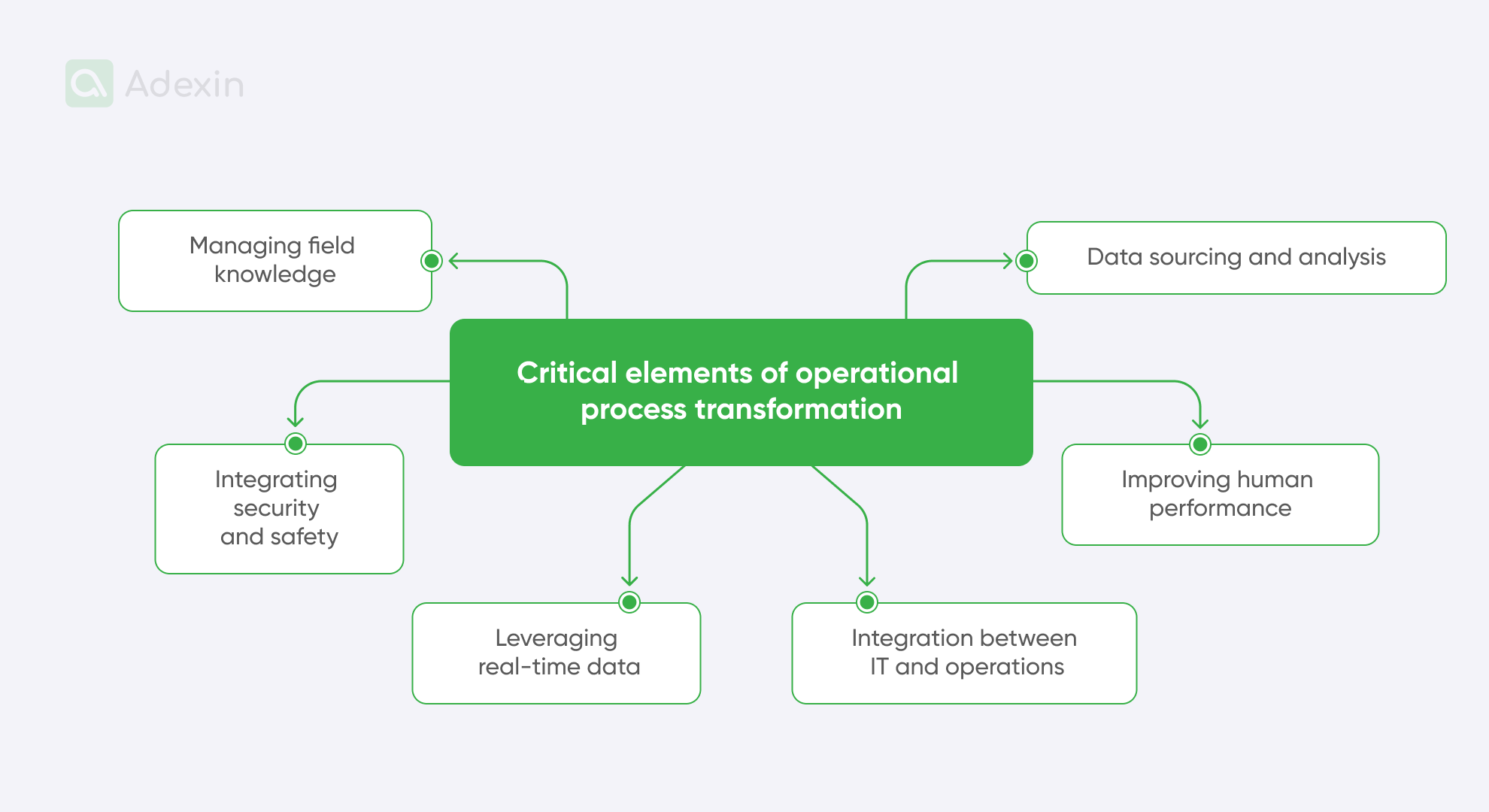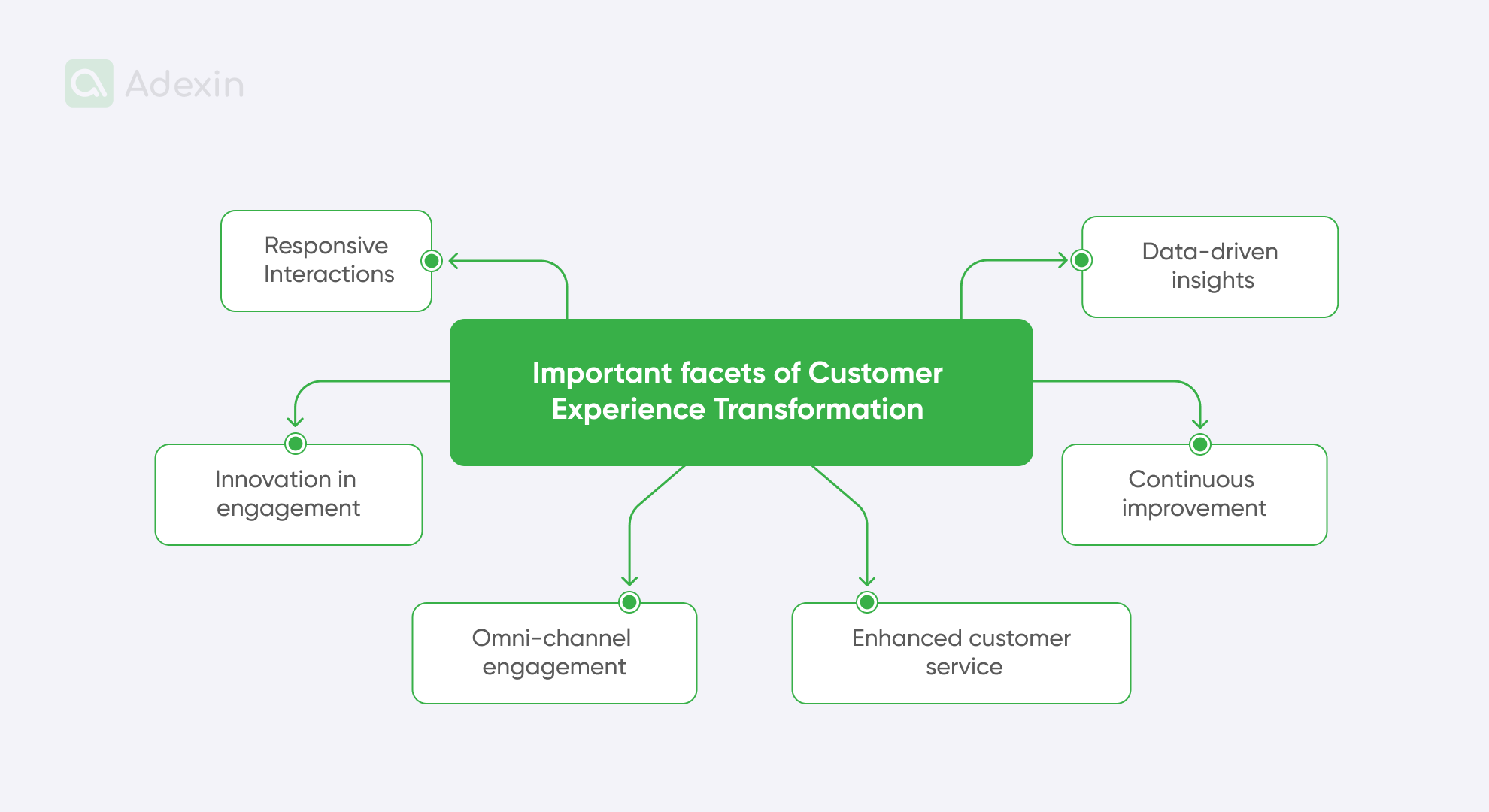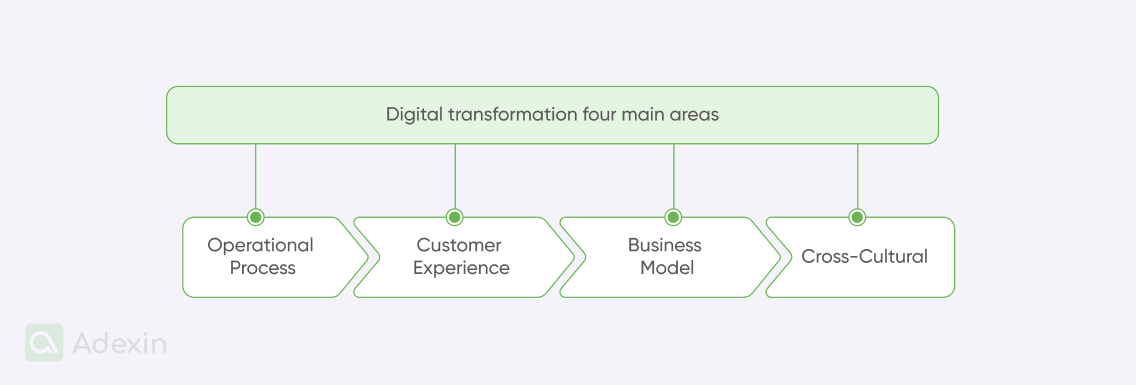Summary
This blog explores four primary areas of digital transformation, including streamlining operational processes, enhancing customer service, revolutionizing business models, and cross-cultural transformation. These pillars optimize internal operations, redefine customer interactions, transform business frameworks, and cultivate innovative adaptability. The post will provide interesting insights into the digital transformation of the supply chain and other industries from a deeper perspective.
Impact of digital transformation on operational processes
Digital transformation represents a comprehensive set of organizational changes to seamlessly integrate technology and digital strategies into all operational aspects. These dimensions include operational process transformation, customer experience transformation, business model transformation, and cross-cultural transformation. Together optimize internal processes, enhance customer engagement, redefine business frameworks, and nurture a culture of innovation and adaptability. The combination of these transformations lies at the heart of the current technology landscape, enabling organizations to grow in the face of disruptive change.
Against unprecedented technological advances, the relationship between businesses and digital transformation has become a key driver of success. Cloud computing is crucial among digital technologies, combining data storage and processing through online platforms. The integration of Cloud, combined with various supply chain elements, facilitates data exchange and leverages the vast capabilities of the Internet. As a result, cloud computing is a driving force in initiating transformational change in the supply chain industry, paving the way for innovation and transforming operational processes. [1]
This evolution, particularly manifested in the sustainable distribution of the supply chain, has redefined operational fundamentals anew. This evolution, particularly manifested in the sustainable distribution of the supply chain, has redefined operational fundamentals in new ways.
Operational Process Transformation
In digital transformation, operational process transformation is key for various industries to improve efficiency, safety, and overall productivity. It is a fundamental aspect of digital transformation, providing a key path for the industry to optimize processes and operations.
The endeavor extends beyond the boundaries of individual industries, embodying a core element of digital transformation that can revolutionize operational frameworks and reveal unprecedented levels of efficiency in the supply chain field.
As the heart of digital transformation, operational process transformation means more than simply adjusting procedures. It embodies a strategic evolution that leverages the power of technology to bring business operations to life.
Critical elements of operational process transformation:
Leveraging real-time data
The cornerstone of this transformation is using real-time data to make critical decisions and facilitate efficient problem-solving. It includes extracting insights from various stages of operations to drive informed action, enhancing responsiveness and agility.
Data sourcing and analysis
Leveraging data from various operational stages is done through advanced technologies such as sensors and automation. It enables organizations to collect data on processes and resources, facilitating in-depth analysis and continuous optimization to unlock operational efficiency. [2]
Improving human performance
Improving human reliability is a major goal. New digital tools, such as operator training simulations and advanced decision support systems, are enhancing the capabilities of workers. Augmented and virtual reality solutions help workers follow protocols and make informed choices, elevating human contributions within digitized processes. [2]
Managing field knowledge
The convergence of information technology (IT) and operational technology (OT) raises the need for effective domain knowledge management. By digitizing domain knowledge in various formats, organizations reduce the risk of knowledge loss due to employee turnover and ensure continuity of expertise, safeguarding institutional insights.
Integrating security and safety
Ensuring safety and security in the realm of digital transformation is of paramount importance. Organizations adopting new technologies must also implement edge computing, data diode systems, and cybersecurity practices to protect operations and data, mitigating potential risks.
Integration between IT and operations
A key change involves integrating information technology (IT) with operational processes. Cloud-based platforms are key in consolidating data from both domains, enabling advanced analytics and informed decision-making. This seamless integration promotes holistic insights and enhances organizational efficiency. [2]
By optimizing processes and operations, entities in the organization can quickly adapt to market changes, minimize inefficiencies and cultivate a culture of continuous improvement. This transformational journey dovetails seamlessly with the broader goals of digital transformation - fostering innovation, customer focus, and increasing competitiveness.

Customer Experience Transformation
Customer experience transformation is a fundamental pillar of digital transformation, including a critical path for organizations to elevate their interaction and engagement with customers. This area involves strategically incorporating digital technologies and innovative strategies to create seamless, personalized, and resonant customer experiences, increasing satisfaction and brand loyalty.
Transforming the customer experience is about more than the transactional engagement of the supply chain. It includes creating meaningful emotional connections that resonate deeply with customers. By thoughtfully weaving digital technologies into the fabric of customer interactions, organizations can create seamless, personalized journeys that evoke a sense of value.
Important facets of Customer Experience Transformation include:
Responsive Interactions
The main goal of this transformation is to provide customized experiences that resonate with individual customer preferences. Organizations can create unique journeys that span digital touchpoints using data-driven insights and artificial intelligence.
Data-driven insights
Leveraging data from various customer interactions and touchpoints enables a comprehensive understanding of customer behavior and preferences. This data-driven approach enables decision-making, enabling companies to anticipate needs and preferences. [3]
Omni-channel engagement
Enabling customers to transition seamlessly between different channels, both online and offline, improves the overall experience. Integrating digital platforms with traditional channels ensures a consistent and uninterrupted journey.
Enhanced customer service
Digital tools such as online chatbots, virtual assistants, and real-time messaging systems improve customer service. These technologies enable rapid response, problem-solving, and proactive engagement. [4]
Continuous improvement
Transforming the customer experience involves a continuous cycle of improvement. Regular analysis of customer feedback, behavioral data, and engagement metrics allows for iterative improvement to ensure that the experience meets changing expectations. [4]
Innovation in engagement
New technologies such as augmented reality and virtual reality are forming the future of customer experience engagement. These immersive experiences facilitate product visualization, virtual trial, and interactive engagement, fostering deeper connections. [4]
At a time of heightened consumer expectations, customer experience transformation is becoming a roadmap to guide organizations toward sustainable growth and differentiation. The ability to predict customer needs, offer customized solutions and provide unparalleled service drives companies beyond mere transactions and into sustainable partnerships. Through this transformative lens, every interaction becomes an opportunity to establish lasting emotional bonds, increasing customer loyalty and advocacy.

Business Model Transformation
Transforming the business model is a central aspect of digital transformation, embodying a strategic path for organizations to change their fundamental approach. It Signifies a strategic pathway for organizations to revolutionize their fundamental approaches to value creation and revenue generation. This dimension encapsulates the deliberate fusion of digital technologies and innovative strategies, ushering in a profound reconfiguration of how businesses navigate and excel in the dynamic landscape.
It changes the way a company operates and goes beyond making practical improvements. In fact, it extends to the company's culture, plans, and how it interacts with customers. By applying digital tools across their operations, companies in the supply chain can transform customer relationships, explore new paths to market and develop agile business strategies capable of adapting quickly in response to changing circumstances.
Core aspects of business model transformation include:
Evolving revenue streams
At the core of this transformation is searching for and establishing new ways to generate revenue, often driven by digital mechanisms. By leveraging technology, companies diversify revenue streams beyond traditional models, enabling dynamic responses to market changes.
Cycle ecosystem dynamics
A key shift is the cultivation of interconnected ecosystems that transcend traditional supply chain boundaries. Collaborative partnerships support value chains that transcend individual companies, unlocking innovative value propositions and broader market access.
Data-driven value
Integrating digital technologies enables different industries to extract information from data. Organizations are transforming data into actionable intelligence, enabling the creation of data-driven products and services tailored to meet evolving customer demands.
Agile response
Integrating digital technologies increases flexibility in business operations. Companies are agilely adapting to real-time market insights, enabling rapid course corrections and optimization to match changing demand dynamics in various industries.
Platform-based collaboration
Digital platforms simplify the organization of supply chain collaboration ecosystems. These platforms bring together diverse stakeholders to enable co-creation and shared value while nurturing innovative partnerships.
Platform support
The development of digital platforms opens the door to arranging ecosystems that connect buyers, sellers, and partners. This approach fosters an environment where value is co-created and shared among participants. [5]
Changing the business model is like taking a bold step into the future, where the ability to adapt, develop new ideas, and deal with digital changes is extremely important. It's like a journey that's not just about surviving in a digital world but also about growing, inventing new things, and being a leader in changing industries. As companies find their way in the new digital world, changing the business model is a sure way to succeed and be relevant in a time when technology is changing really fast.
Cross-Cultural Transformation
In the context of digital transformation, cultural transformation is emerging as a powerful catalyst, profoundly affecting the way organizations conceptualize and cross-adopt technological evolution. Doing so involves a recalibration of cognitive behavior, behavioral norms, and workforce competencies. At the same time, it cultivates an ecosystem that embraces digital ventures and learns to operate within their field.
Analogous to a magnetic influence, this development resonates at the heart of an organization, catalyzing profound change. It goes beyond mere technical assimilation, delving into the intricacies of human psychology, attitudes, and interactions while extending its influence into supply chain dynamics. [6]
Essential elements of cultural transformation in the context of digital transformation involve:
Innovation-oriented culture
Central to this transformation is the nurturing of an innovation-oriented culture. Organizations encourage employees to challenge the status quo, experiment with new ideas, and explore unconventional solutions, fostering a continuous flow of innovative thinking. This culture becomes the catalyst for ground-breaking solutions that drive progress. [6]
Adaptive thinking
Cultural transformation encourages an adaptive mindset in which employees constantly embrace change. This shift in perspective allows organizations to easily respond to digital advances by effectively navigating disruption and opportunity, enabling agile responses that keep them ahead of the curve.
Continuous learning
Digital transformation involves the continuous pursuit of knowledge. Organizations promote continuous learning and upskilling, ensuring employees have the competencies to use digital tools and technologies effectively. This commitment to learning ensures that digital transformation remains a sustained growth journey.
Desire to innovate
A key aspect of cultural transformation is fostering a willingness to experiment. Employees are encouraged to test new approaches, learn from failures, and iterate, fostering an environment where experimentation drives growth. This spirit of innovation becomes the driving force behind dynamic and disruptive breakthroughs.
Collaborative community
Digital transformation evolves in collaboration. Cultural transformation stresses teamwork, breaking down silos, and promoting cross-functional collaboration, ensuring seamless integration of digital initiatives across departments. This collaborative synergy amplifies the impact of digital transformation, resulting in holistic and far-reaching outcomes.
Leadership Role Modeling
Cultural transformation begins at the top, where Leaders exemplify the values and behaviors they seek to promote at work. Through their actions, they set the tone for embracing change, encouraging open communication, and fostering an environment of trust. [6]
Cross-cultural transformation fundamentally works like a compass that guides organizations through the uncharted territories of digital time. It enables employees to bridge the gap between their innate capabilities and the demands of digital operations. When organizations embrace this transformation, they cultivate a harmonious environment where technology is embraced and seamlessly integrated into daily operations.
Foster organizational evolution through digital transformation
Cultural transformation in the context of digital transformation represents a deep recalibration of the fundamental essence of an organization. By cultivating a culture characterized by innovation, adaptability, and continuous learning, companies are laying the foundation for organizational growth.
Summarizing the crucial components of digital transformation in four main areas with perspective on quick benefits:
Area of digital transformation | Quick benefits |
|---|---|
This transformational journey turns employees into agents of change, equipping organizations to survive and thrive in an environment where technology adoption is critical to sustained success. In the same way that operational process transformation improves efficiency and flexibility, customer experience transformation shapes deep customer relationships, and business model transformation redefines value creation. Digital transformation is redefining value creation and integrating digital technologies into different industries and areas, such as supply chain, logistics, and further refining and redefining the dynamics of efficient and flexible operation.

Footnotes:
[1] IMPACT OF ICT ON HUMAN RESOURCE MANAGEMENT - Retrieved from: https://www.academia.edu/12682490/IMPACT_OF_ICT_ON_HUMAN_%20RESOURCE_MANAGEMENT
[2] Digital Transformation and Its Influence on Sustainable Manufacturing and Business Practices - Issam A. R. Moghrabi, Sameer Ahmad Bhat, Piotr Szczuko, Rawan A. AlKhaled, and Muneer Ahmad Dar - Retrieved from: https://www.mdpi.com/2071-1050/15/4/3010
[3] Deloitte US – research institute - Retrieved from: https://www2.deloitte.com/us/en/pages/consulting/solutions/operations-process-transformation.html
[4] McKinsey & Company - values-driven organization - Retrieved from: https://www.mckinsey.com/capabilities/growth-marketing-and-sales/our-insights/what-matters-in-customer-experience-cx-transformations
[5] Digital directions is an emerging online publication about digital transformation. - Retrieved from: https://digitaldirections.com/examples-of-business-model-transformation/
[6] BTOES Insights is a professional online content platform - Retrieved from: https://insights.btoes.com/what-is-cultural-transformation
